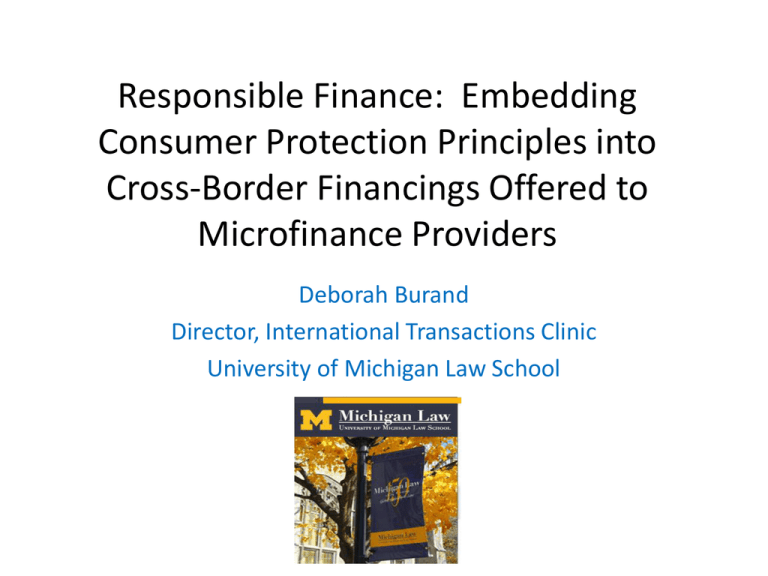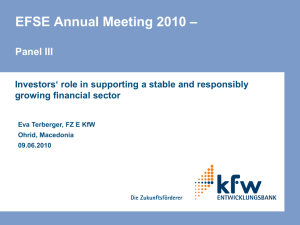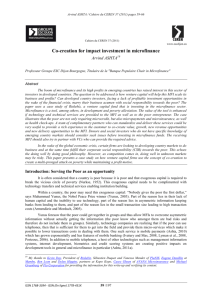Appropriate Collections Practices. - Institute for International Law
advertisement

Responsible Finance: Embedding Consumer Protection Principles into Cross-Border Financings Offered to Microfinance Providers Deborah Burand Director, International Transactions Clinic University of Michigan Law School What is microfinance? Microfinance is often defined as financial services for poor and low-income clients. In practice, the term is often used more narrowly to refer to the loans and other services from providers that identify themselves as “microfinance institutions” (MFIs).… More broadly, microfinance refers to a movement that envisions a world in which low-income households have permanent access to a range of high quality financial services to finance their income-producing activities, build assets, stabilize consumption, and protect against risks. These services are not limited to “microcredit,” but also include savings, insurance, and money transfers. Source: CGAP website, www.cgap.org (What is Microfinance?) “Halo effect” of 2006 Nobel Peace Prize Awarded to Muhammad Yunus and Grameen Bank “Today, Grameen Bank gives loans to nearly 7.0 million poor people, 97 per cent of whom are women, in 73,000 villages in Bangladesh. Grameen Bank gives collateral-free income generating, housing, student and microenterprise loans to the poor families and offers a host of attractive savings, pension funds and insurance products for its members.” Nobel Lecture delivered by Muhmmad Yunus (December 10, 2006) Profitability: A Growing Driver In India, Vikram Akula, the founder of SKS Microfinance, the country’s largest microlending bank, says he is modeling his growth plans on “Coke, Starbucks and McDonald’s.” He describes Yunus as his “inspiration”, but says it is time for a younger generation of bankers to “push it to the next level ... with the unabashed goal to be extremely profitable.” • Source: The Sunday Times, October 4, 2009, “World poverty guru ‘fails’ to spread wealth” Boom in microfinance 2000-2007 Total Assets of MFIs (USD bn.) (reported to MIX) 60 50 40 30 20 10 0 2000 2001 2002 2003 2004 2005 2006 2007 Source: CGAP analyzing MIX Market data. Total assets are for all MFIs reporting to the MIX market. As of July 2009, 1400 MFIS were reporting to the MIX. Quantity at expense of Quality? Survey of 430 respondents from 82 countries and multinational institutions … biggest risk confronting microfinance sector today is credit risk. Source: Microfinance Banana Skins Report 2009: Confronting Crisis and Change “… over-indebtedness of clients is emerging as a key problem in the microfinance sector.”Sanjay Sinha, Managing Director of M-CRIL quoted in Microfinance Banana Skins Report 2009 What are key consumer protection challenges in microfinance? - Lack of transparent pricing on credit products - Over-indebtedness of clients - Unclear/one-sided loan agreements favoring Lender - Inappropriate debt collection practices - Lack of accessible/affordable dispute resolution processes (including lack of consumer advocates) How have actors in microfinance sector responded to consumer protection issues? • Self-regulation and self-assessment by MFIs • Adoption of codes of conduct by MFIs and local/international networks • Market conduct regulation imposed by local supervisory authorities • Recent launch of consumer protection research and action/resource/policy initiatives (Campaign for Client Protection launched in March 2009; Microfinance Transparency launched in July 2008) • Endorsement of Client Protection Principles by MFIs, Donors and Investors Microfinance Transparency Launched Client Protection Principles 1. Avoidance of Over-Indebtedness. Providers will take reasonable steps to ensure that credit will be extended only if borrowers have demonstrated an adequate ability to repay and loans will not put the borrowers at significant risk of over-indebtedness. Similarly, providers will take adequate care that non-credit, financial products (such as insurance) extended to low-income clients are appropriate. 2. Transparent Pricing. The pricing, terms and conditions of financial products (including interest charges, insurance premiums, all fees, etc.) will be transparent and will be adequately disclosed in a form understandable to clients. 3. Appropriate Collections Practices. Debt collection practices of providers will not be abusive or coercive. 4. Ethical Staff Behavior. Staff of financial service providers will comply with high ethical standards in their interaction with microfinance clients and such providers will ensure that adequate safeguards are in place to detect and correct corruption or mistreatment of clients. 5. Mechanisms for Redress of Grievances. Providers will have in place timely and responsive mechanisms for complaints and problem resolution for their clients. 6. Privacy of Client Data. The privacy of individual client data will be respected, and such data cannot be used for other purposes without the express permission of the client (while recognizing that providers of financial services can play an important role in helping clients achieve the benefits of establishing credit histories). Source: Center for Financial Inclusion at ACCION, www.accion.org. Investor Responses “I hope and think that MFIs that will embed client protection principles into their core business activities will have a competitive advantage, with all stakeholders: not just with clients but with investors, donors, governments, and policy makers. Pricing transparency along with efficiency and yield analysis shows the organisation understands the nature of its business and is actively managing its margins and how they are allocated to different shareholders .” -JM, Triodos Bank (Source: Microfinance Transparency, October 2009 presentation) MIVs: independent investment entities that specialize in microfinance with at least 50% of portfolio in microfinance Assets under management in top 10 MIVs reached USD$4 billion in 2008 2007 USD 116 114 Omidyar/Tufts Fund Dual Return Fund, Vision Microfinance Subfund ASN-Novib Fund responsAbility SICAV (Lux) Microfinance Leaders Fund SNS institutional Microfinance Fund 2008 USD 55 116 120 122 160 201 117 responsAbility Global Microfinance Fund Dexia Microcredit Fund Oikocredit EFSE Pro Credit Holding AG Source: CGAP Presentation, October 2009 243 193 378 298 429 569 632 587 745 800 1019 Investor Responses CGAP 2009 MIV Survey found that: -- there were 103 MIVs with Assets under Management (AUM) of USD$6.6 billion as of December 2008 -- of these MIVs, 63% have endorsed the Client Protection Principles* (* Nearly equal amount (61%) report ESG information to investors) Endorsement of Client Protection Principles As of December 1, 2009, over 90 investors and donors to the microfinance sector had endorsed the Principles. Source: Center for Financial Inclusion at ACCION International (www.accion.org) But how meaningful are these investor/donor endorsements at changing behaviors of MFIs (or of the investors/donors)? Recommended Actions for Investors 1. 2. 3. 4. 5. 6. 7. Incorporate the Principles into investment policies. Endorse the Principles publicly. Encourage current and prospective investees to discuss and endorse the Principles. Develop, test, and refine criteria and procedures to assess investee implementation of the Principles during screening and due diligence processes. Integrate the Principles into financing or shareholder agreements, as appropriate. Monitor implementation of the Principles by investees through mandatory reporting and regular monitoring and evaluation. Report on progress to investors and other stakeholders. Source: Implementing Client Protection Principles: A Technical Guide for Investors (published by CGAP September 2009) Embedding Consumer Protection Principles into Cross-Border Financings BUT … In this early stage, most investors are NOT integrating the Principles into the documentation evidencing their financing or shareholder agreements with MFIs They also typically are NOT requiring current or prospective investees to join Campaign for Client Protection and endorse the Principles Instead, most investor focus is on (i) incorporating the Principles into investment processes – screening, due diligence, raising awareness in conversations with potential MFI investees, and monitoring/evaluation of investments, and (ii) reporting on progress to shareholders and other stakeholders Source: Implementing the Client Protection Principles: A Technical Guide for Investors (September 2009) KfW: First Mover at Embedding Consumer Protection Principles into Documentation for Cross-Border Financings of MFIs “The Borrower shall fully comply with all existing and future national laws and regulations on consumer protection especially in the area of financial services. The Borrower shall in particular provide its customers with clear and comprehensive information on the main characteristics of the financial services the customers seek. The Borrower shall, for example, have thoroughly informed its customers in good time before the signing of the loan agreement on the terms and conditions of the loan in a way easily understandable for the customer. These loan agreements shall further contain such information and shall be drafted in a manner the customers are able to understand. Furthermore, the Borrower shall critically review the customer’s repayment capacities before signing a loan agreement and shall refrain from any form of unfair or even harmful debt collection practices.” Excerpt from KfW form of loan agreement Local Laws and Regulations “The Borrower shall fully comply with all existing and future national laws and regulations on consumer protection especially in the area of financial services.” Question: Are local laws and regulations on consumer protection in financial services developed enough to give this covenant some teeth? Answer: Mixed Tanzania Article 27.(1) The contract between the bank or financial institution and the borrower, must state the nominal rate, as well as commissions and fees, either on an annual or a monthly basis. (2) The borrowers shall be permitted to make partial or total prepayments on their microcredits. Penalties for prepayment, if any, shall be described in the contract. (3) It shall be prohibited to impose or assert any contractual term or condition granting the Microfinance Company authority to introduce unilateral modifications to interest rates or other loan conditions. (4) Microcredit contracts may establish an indexed interest rate, designed to vary in line with a reference rate published by the Bank. (5) The Bank shall monitor the collection practices of institutions engaged in microcredit and shall instruct institutions to discontinue those that, in its opinion, are abusive. Source: Microfinance Companies and Microcredit Activities Regulations 2004. Zambia 30.(1) A deposit taking microfinance institution that provides credit facilities to a customer shall at the time of providing the service, in a statement in writing, disclose to the customer concerned the cost of borrowing…. 31.(1) A microfinance institution shall display in a conspicuous place on the premises of every branch where it conducts business a notice containing – (a) a clear and simple summary of the business conducted by the microfinance institution; (b) information on customer rights and responsibilities; (c ) details on the financial products offered; and (d) the terms under which any financial product is offered. Source: Statutory Instrument No. 3 of 2006 (January 30, 2006); The Banking and Financial Services (Microfinance) Regulations, 2006. Truth in Lending/Transparency “The Borrower shall in particular provide its customers with clear and comprehensive information on the main characteristics of the financial services the customers seek. The Borrower shall, for example, have thoroughly informed its customers in good time before the signing of the loan agreement on the terms and conditions of the loan in a way easily understandable for the customer.” Why encouraging transparent pricing in microfinance is so hard • There is no “single interest rate” or consensus yet for how to communicate to customers the comparable costs of similar microfinance products • MFIs have very different products and they need to be priced very differently • Difficult to communicate and educate the public about these issues • Disclosing actual effective interest rates can be politically sensitive • There can be a “transparency penalty” that disadvantages transparent MFIs relative to their less transparent competitors • Price may not be most important factor in determining customer’s choice of products Source: Drawn, in part, from Microfinance Transparency, October 2009 presentation Developing Understandable Loan Documentation “These loan agreements shall further contain such information and shall be drafted in a manner the customers are able to understand.” Why is creating understandable microcredit documentation so hard? • Clients may be illiterate • Even if clients are able to read language of microcredit documentation, this may be first contract they have ever encountered • General lack of consumer advocates/educators who can explain documentation to clients and perform watchdog role Repayment Capacity/Debt Collection “Furthermore, the Borrower shall critically review the customer’s repayment capacities before signing a loan agreement and shall refrain from any form of unfair or even harmful debt collection practices” Why is determining a customer’s debt repayment capacity so hard? - Lack of reliable information about customer’s credit history (lack of credit bureaus, lack of national identification systems, etc.) - Customers often borrow and manage finances on a household, not individual, basis - Most customers not ‘salaried’ so hard to measure income levels with any reliability Why are appropriate debt collection practices hard to define and enforce? • Cultural differences across regions • MFIs likely to be assertive in pursuing defaulting borrowers for “demonstration effect” to prevent “borrower runs” (even when financial costs of debt collection overwhelm likely recovery) • Lack of efficient, fair, transparent, inexpensive, accessible dispute resolution fora can give rise to vigilante behaviors by MFIs (and/or their agents/staff) • Significant financial incentives imposed on MFIs by investors (and on credit officers by MFIs) to maintain excellent repayment ratios • Lending methodologies/technologies may rely on agents (formal and/or informal) for debt collection/enforcement without offering adequate guidance to or imposing effective accountability on such agents (financial incentives may skew any guidance/accountability that is put in place) Just because it is hard to do is no excuse for not doing something What is at stake: Reputation and health of investors in microfinance sector Reputation and health of microfinance sector Livelihoods and well-being of customers of microfinance providers Another way to go… reframe the question Question: What kind of microfinance providers do we want to encourage to operate? If answer is: Microfinance providers who are keenly interested in improving the welfare of their customers through the provision of appropriately designed and distributed financial services and products Then …. Another approach to embedding Consumer Protection Principles into Cross-Border Financings Develop contractual provisions in financings that require MFI to: 1) Adopt internal codes of conduct and systems for monitoring adherence to such codes 2) Continually evaluate (and report) on the impact (intended and unintended) of their products and services on their target customers MORE ABOUT THE ITC For additional information regarding the ITC, please visit our website at: www.law.umich.edu/centersandprograms/clinical/internationaltransactionsclinic Michigan Law – 1859-2009 Global Leadership in Law 31






